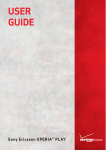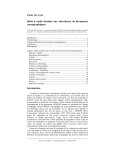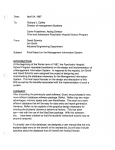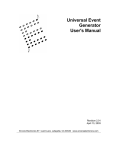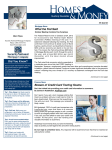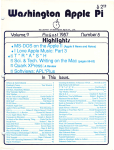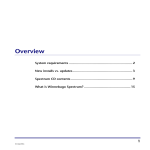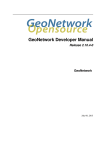Download Website User Manual
Transcript
Website User Manual August 2010 ©Bridgeman Education - Tel: +44 (0)20 7908 1605 [email protected] Contents: I. Introduction to the new site II. Searching: i. Quick Search ii. Advanced Search iii. Subject Categories iv. Search Tips III. Viewing Images: i. Results View ii. Detailed image view iii. Zooming IV. Saving and Retrieving Images V. The Slideshow: i. Creating a slideshow ii. Viewing a slideshow iii. Saving and editing a slideshow iv. Retrieving a slideshow v. Downloading a slideshow Dr. Samuel Johnson (1709-84), 1775, Sir Joshua Reynolds (after) VI. Other Bridgeman Services ©Bridgeman Education - Tel: +44 (0)20 7908 1605 [email protected] I. Introduction to the new Bridgeman Education Website The new Bridgeman Education site has been developed on the basis of research carried out by our post-doctoral researcher during the course of a government funded project into the ICT needs of the educational e-learning sector. Building on the experience and feedback gathered over the years, our new site provides all the functionality of the previous version as well as enhanced and additional features such as: • Detailed usage statistics – available on request or via Counter • Shibboleth access • Compliance to standards such as COUNTER, Z3950 and Open URL • Compliance to W3C standards for accessibility and disability • Improved slideshow function with 3 viewing options fully exploiting web 2.0 • Touch-screen friendly – ideal whiteboard tool • Zoom feature and ability to capture details and store in the slideshows • Interactive learning modules available from October 2010 to subscribers • Many more images added from museums, private galleries and historical societies around the world This manual explains the many ways in which to use the site in order to get the most out of our vast resource. For all further questions please get in touch with the Bridgeman Education team – the contact details can be found at the foot of each page. ©Bridgeman Education - Tel: +44 (0)20 7908 1605 [email protected] II. SEARCHING Bridgeman Education offers two search functions: the Quick and the Advanced search as well as a range of indexes or Subject categories available to all subscribed members. i. Quick Search: This is a 'Google' type search using keywords, which will retrieve results containing one or more of the keywords you enter into the Search field. The results will be sorted by relevance, i.e. results corresponding to all search terms first then in decreasing relevance. You can also change this option and organise your search results by ‘most recent’. For example, a search using the keywords Hopper, woman and street will first retrieve results containing all three words then two of them and finally all results with one of the keywords. ii. Advanced Search The Advanced Search allows you to narrow down the focus of the search by including details such as; - the artist's name - picture/image title - its location (as in where the original is kept e.g. ‘Louvre’) - the image number (this is the Bridgeman Education catalogue number that appears at the foot of each image) - century (typed C19th) (or –C06th for BC dates) - medium (photograph, oil on canvas, stone, watercolour etc) Location refers to the current location of the work – country or institution. Nationality can sometimes be flexible for example English rather than British depending on the period of the work. ©Bridgeman Education - Tel: +44 (0)20 7908 1605 [email protected] You can combine these terms within the Advanced Search box to increase your chances of success and then choose how your results are sorted, either by: Relevance, Image Number, Artist Name, Artist Nationality or Medium: The Advanced search function is particularly useful when looking for artists with a generic name such as Black, Jones, etc, or images at a specific location such as the Prado, Washington D.C., Guggenheim, Louvre and so on. ©Bridgeman Education - Tel: +44 (0)20 7908 1605 [email protected] iii. Subject Categories: These are pre-created image selections put together by staff at Bridgeman Education. We currently have 11 categories live on the site grouping our collection by topic, period, school, movement or according to areas of study such as, Graphic Design, Geography, Medicine and many more. We have also created conceptual selections based on emotions and others classed according to medium. We add to our subject categories regularly and are happy to hear of any gaps that you might want filled or categories that need adding to. Each category is divided into several sub-categories, providing more detail and specific content on each subject. Once you have opened a subject category you will find a series of topics listed within it that in turn can be clicked on, leading to specific image selections (see next page). ©Bridgeman Education - Tel: +44 (0)20 7908 1605 [email protected] Here is our Chinese Art category as an example: ©Bridgeman Education - Tel: +44 (0)20 7908 1605 [email protected] iv. Search Tips: You can try the following to narrow down you results: - Minus or negative search: use to exclude certain results. Enter a minus sign without a space in front of your search term: Another example would be to type in Jean-Francois Millet NOT landscape the search will remove all of Millet’s landscapes and narrow the results down to mainly portraits. - use OR: Add OR to your keyword searches to ensure that you retrieve all possible results around one topic: - Spelling In order to increase your chances of finding the right results try using different spellings. For example, when looking for St Mark’s Venice also try searching SAN MARCO. ©Bridgeman Education - Tel: +44 (0)20 7908 1605 [email protected] Similar examples are: • Mohammad II - try MOHAMMED II • ALIXI, ALEXEI, ALEXY etc. Similarly, when looking for images associated with a particular movement, style or period try the following: • Impressionist not – ism • Expressionist not – ism • Realist not – ism You could also refer to our Subjects page menu as you will find a lot of these subjects already pre-selected for you. - Keywords Once you find an image, be sure to look at the keywords listed on the right hand side – click on these words to lead you to other related results. Try using fewer keywords in your searches as, the less keywords used, the broader the selection of results. Think laterally when searching. For example, if you are looking for images of an event that occurred in a certain place at a specific time try using all related keywords in order to broaden your search. Eg. Berlin wall, 1989, Germany, photograph, reunion, celebration, cold war etc. You can also try moods, colours & forms eg: blue, green, colourful, conceptual, geometric, shape, jealousy, happiness, contemplation, sadness, atmospheric, spiritual, merriment, melancholy and so on. The Subjects category also contains a preselected conceptual index. NB. When searching for men or women be sure to enter male/female as search term keywords as well. - Boolean Search Using a star (*) or ‘wildcard’ word prefix will help you find words with the same beginning and multiple endings. For instance: Kand* will bring up images of Kandinsky whether they are written with a y or an i. This feature is great for plurals and languages like Russian or movements such as Romantici –st or –ism - Bound search “Tiger, Tiger Burning Bright” or “dejeuner sur l’herbe” or “word play” to narrow down your results to specific titles or wording. ©Bridgeman Education - Tel: +44 (0)20 7908 1605 [email protected] III. VIEWING IMAGES i. Results view: Search results will first be displayed at thumbnail size across one or more pages. The total number of results will be given at the top of the page (number of images and number of pages) as well as the manner in which the results have been sorted; by relevance, Image Number, Artist Name, Artist Nationality or Medium. You can change this order by using the drop down box circled below. The number of result pages is on the right – both at the top and the bottom of each page – you can use the arrows to move between the pages and to go straight to the last or first page of results. In thumbnail format you get partial captions: The title of the work, name of the artist and dates where known as well as the Bridgeman reference number. Two icons below the image – the + sign and the magnifying glass allow you to add the result to a slideshow or to zoom (see below). ©Bridgeman Education - Tel: +44 (0)20 7908 1605 [email protected] ii. Detailed image view: If you want to view the larger version of the image either click on More info or simply double click on the image itself. This will open a new window in which you can view the complete image details, including keywords that can be clicked upon to take you to related results. Above and below the image details and keywords on the right hand side are three arrows: • takes you to the previous image from the search in full screen view • takes you back to the results thumbnail overview page ©Bridgeman Education - Tel: +44 (0)20 7908 1605 [email protected] • takes you to the next result in the search in full screen view iii. Zooming: From this page you can also zoom into the image and view it in detail. Simply click on the magnifying glass icon or zoom image in the top right of the page, above the image info: Not all our images have been scanned to a high enough resolution to allow for zooming. If this is the case you will get the following message: ©Bridgeman Education - Tel: +44 (0)20 7908 1605 [email protected] If the image is zoomable your screen will go grey and the image will reload over the greyed out page. Once the high resolution version has loaded it will ‘float’ gently on your screen. Using the mouse you can drag it around and to stop it moving simply click anywhere on the image. A control panel can be accessed by clicking the arrow tab in the left-hand corner of the magnified image. ©Bridgeman Education - Tel: +44 (0)20 7908 1605 [email protected] - The control panel: These buttons let you move to different areas of the magnified image. This arrow minimises the control panel These bars show you the level of magnification. Click on them to increase or reduce the zoom level. Click for full screen (Esc to return to the screen in screen view) This shows you which part of the image you are currently viewing n magnification. To return to the full screen view without magnification, simply close the zoom view by clicking the on the top right-hand corner. You cannot save the magnified version of the image! To save the image you will need to return to the standard image view. See the next section IV. SAVING AND RETRIEVEING IMAGES ©Bridgeman Education - Tel: +44 (0)20 7908 1605 [email protected] IV. SAVING AND RETRIEVING IMAGES Saving and retrieving images from the Bridgeman Education site couldn’t be easier. You can either save the images individually direct to your computer or you can save them as a light box or slideshow online. - Individually: This is the fastest and easiest way of saving images from the site. Once you have completed your search and arrived at the results page, simply open the image you are interested in saving by clicking on it. Then right click and select Save Picture As… this will then open your Documents folder on you hard drive, allowing you to save the image with the title of your choice wherever you want within your own files. The following instruction can be found under each individual image across the site: To download the above image or to copy it so it can be pasted into documents on your local computer, right click on the image (or Control click it if you use a Mac). This should give you a menu allowing you to download or copy the image. For information on how to save and retrieve images using the Slideshow function please see the next section: V. THE SLIDESHOW. ©Bridgeman Education - Tel: +44 (0)20 7908 1605 [email protected] V. THE SLIDESHOW The Slideshow function allows you to put together your own collections of images, which you can then annotate, view and download. This is a handy way of keeping selections of images available online so that you can retrieve them from different locations and computers. You can then review your selection and save and discard form it as appropriate at your leisure. Slideshows offer non-proprietary software, meaning that images can be saved as JPEGs and incorporated into any software (such as PowerPoint). Your subscription also allows you to save images to a VLE – a virtual learning environment or Learning Platform (LP). The slideshow tool bar features on every page of the site and can be found at the top right hand corner: The icons and the white box at the far right will all become ‘active’ once images are added to the slideshow. i. Creating a Slideshow: To add images to a slideshow simply click on the 'Add to slide show' button found underneath every image in search results (see Searching). Once added you should see the image appear in the thumbnail viewer in the top right of the screen: . At any one time you may have one slideshow open. Images are always added to the open slideshow unless you open a new one. ©Bridgeman Education - Tel: +44 (0)20 7908 1605 [email protected] ii. Viewing a slide show: Clicking on the 'View slide show' button opens the slide show viewer. There are three different types of viewers which can be selected from the pop out panel to the left of the viewer. Default/Basic viewer Rotator viewer Wall viewer Full screen Display information The default or basic viewer allows you to browse through your images using the backwards and forwards navigation arrows at the bottom of the viewer. You can also chose to view one, two or four images at a time using the selectors on the pop out panel on the right. You can also have a full screen view by clicking on the relevant icon in the control panel. The other two viewers: rotator viewer and wall viewer allow you to browse through your images in more visually engaging ways (See examples below). ©Bridgeman Education - Tel: +44 (0)20 7908 1605 [email protected] The Rotating viewer allows you to pull the images along in a circular motion using your mouse or, by hand in the case of whiteboards and touch screens. ©Bridgeman Education - Tel: +44 (0)20 7908 1605 [email protected] The Wall viewer displays the images at an angle letting you pull them from left to right and then stopping on the image you choose. This is particularly successful on a touch screen. Whichever viewer you are using, if you hold the mouse pointer over an image, its title, artist and any caption you have added will become visible, and if you double-click on an image you will be able to zoom into a very high resolution version of the image. You can then use the return icon to go back to your slideshow. ©Bridgeman Education - Tel: +44 (0)20 7908 1605 [email protected] iii. Saving and editing slideshows: You do not need to save a slideshow immediately: all changes you make to your slideshows are automatically saved for four weeks as you go along. However, in order to make a slideshow permanent you must name it. To name and edit a slideshow click on the to the slideshow as well as notes about it. 'Save and edit the current slide show' button. This opens the Editor tool, which allows you to add a name Once a slide show is named it is permanent. If you wish to delete a slideshow, remove its name and in a month it will be deleted from the system. Unnamed slideshows are deleted one month after they were created. If you are using Bridgeman Education through a school or university the slideshows you create are public to all other users in your school or university. In order to make them private you can give a name in the 'owner' box. When you do this only people who know the owner name will be able to access those slide shows. We suggest you use your email address, or you can use something more difficult to guess if you want your slide shows to be very private. ©Bridgeman Education - Tel: +44 (0)20 7908 1605 [email protected] - Re-ordering Using the editor tool you can also change the order of the images in your slideshow by dragging and dropping them into the appropriate place. - Captioning If you double-click on an image this brings up the image editing window which allows you to edit the title and artist and add a caption. Captions can then be viewed in all the image viewers and can be used as class notes. ©Bridgeman Education - Tel: +44 (0)20 7908 1605 [email protected] - Deleting To delete an image from a slideshow double-click on it in the slideshow editor and then click on the delete button (the rubbish bin icon) in the image editor window. - Cropping You can also create a crop of the image by clicking the crop button. This will open a new window with a high resolution copy of the image (when available) with a cropping box. You can drag and resize the crop box on the left of the screen and the crop you create is visible on the right. ©Bridgeman Education - Tel: +44 (0)20 7908 1605 [email protected] The crop box is a limited size only. You can return to the un-cropped version of the image by simply clicking on the window saves all the changes you have made . Closing the image edit NB: If you are cropping an image, it is a good idea to save two copies of the same image into the slideshow before you start so that you end up with your cropped image and the un-cropped original for future reference if needed. - Clearing a slideshow Click on the Clear the current slide show button will let you create a new slideshow. It won’t delete the previous one, this can still be retrieved from the drop-down list once you click on the retrieve slideshow icon (see below). iv. Retrieving a slideshow: The 'Reload an existing slide show' button in the slideshow tool bar (at the top of each page of the site) brings up a menu of the slideshows you have created. All the public, named slideshows are listed alphabetically, and clicking on the name makes that slideshow the current slide show meaning it can be viewed, added to or edited. If you are a user in a school or university and have created private slideshows by giving them an owner name (see the section on editing slideshows above) enter the name of the slideshow in the Private slide shows box. This will then reveal all the slideshows saved under that owner name. The bottom part of the drop-down reveals all unnamed slideshows listed in reverse date order. All slideshows will either have names or be saved by date. ©Bridgeman Education - Tel: +44 (0)20 7908 1605 [email protected] v. Downloading a slideshow: Ideally, the slideshow is best used online through the Bridgeman Education website. It can be retrieved through any browser on any computer with your username and password if you are out of IP range. However, if you wish to download your slideshow we have two options. First of all you will need to load the relevant slideshow as described above so that is becomes the current slideshow, visible in the preview box in the slideshow tool bar. Then click the Download the current slideshow icon in the tool bar: This will open a new window with two download options, click to select whether you want a zip file or a pdf as seen below: - Zip file: ©Bridgeman Education - Tel: +44 (0)20 7908 1605 [email protected] - Pdf document: This effectively gives you a print out view of the images as thumbnails with their captions and information. The best way of viewing the images offline is to save them individually and then incorporate them into a PowerPoint or similar program as this will give you greater flexibility. ©Bridgeman Education - Tel: +44 (0)20 7908 1605 [email protected] VI. OTHER BRIDGEMAN SERVICES Your Bridgeman Education license covers you for all educational non-commercial use of our images. If you would like to use one of our images for a published paper, a book or paid lecture you will need to ask us for a new licence for that one use. This is quick and easy, simply call or email [email protected] and we will give you a price quote and let you know if any additional rights or restrictions apply. - The Bridgeman Art Library The Bridgeman Art Library is our commercial branch, making the best of the world’s cultural and historic images available for reproduction whilst supporting museums, artists and collections across the globe. - Art on Demand Bridgeman Art on Demand is an online print and poster service where you can buy framed fine art prints, posters, paintings, canvas prints, postcards of your favourite artworks.. • High quality iconic masterpieces • Exclusive hidden treasures • Affordable contemporary art • Select the size and frame you want delivered to your door There is a link from our site – simply go to the Buy Prints tab in the About section, or you can use the link below. www.bridgemanartondemand.com - Education Posters As a Bridgeman Education subscriber, you are entitled to a series of full colour A3 posters specially designed for the classroom and library. Choose from a range of some 15 posters which are being added to regularly. For more information, please contact [email protected]. ©Bridgeman Education - Tel: +44 (0)20 7908 1605 [email protected]



























